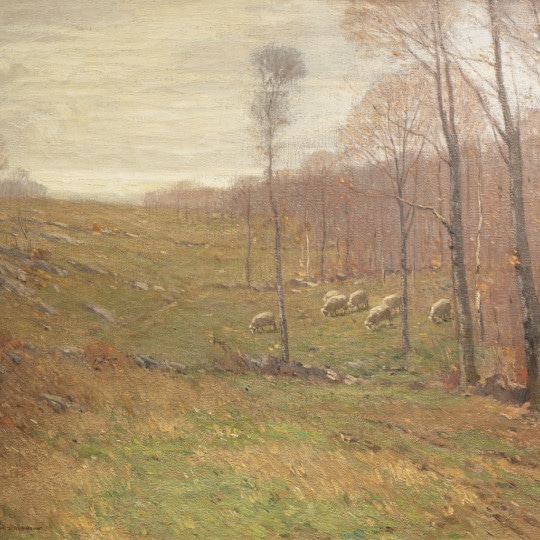Artist Biography
Born in East Gloucester, Massachusetts, William Smith Robinson is known for his impressionistic landscapes and seascapes of New England and Mississippi. The son of a fisherman, his early career was in marine subjects. In the early 1880s, he taught in the Boston area and from 1885 to 1889 at the Maryland Institute in Baltimore. In the early 1890s, he traveled to Paris to study at the Académie Julian. Upon returning to the United States, he began exhibiting his work and resumed teaching, this time in New York and Philadelphia. In 1905, Robinson traveled to the boardinghouse of Florence Griswold in
Born in East Gloucester, Massachusetts, William Smith Robinson is known for his impressionistic landscapes and seascapes of New England and Mississippi. The son of a fisherman, his early career was in marine subjects. In the early 1880s, he taught in the Boston area and from 1885 to 1889 at the Maryland Institute in Baltimore. In the early 1890s, he traveled to Paris to study at the Académie Julian. Upon returning to the United States, he began exhibiting his work and resumed teaching, this time in New York and Philadelphia. In 1905, Robinson traveled to the boardinghouse of Florence Griswold in Old Lyme, Connecticut, and began living and painting there over the next two decades. When the new building for the Lyme Art Association opened, Robinson became a charter member and eventually president. He was also president of the American Watercolor Society from 1914 to 1921, and a member of the National Arts Club, Salmagundi Club, Lotos Club, and academician of the National Academy of Design. Robinson won awards and honorable mentions at the Paris Exposition of 1900, Pan-American Exposition in Buffalo (1901), St. Louis Exposition (1904), International Exposition in Buenos Aires (1910), and the Panama-Pacific Exposition in San Francisco (1915), as well as prizes at the clubs of which he was a member. After Griswold’s death in 1937, Robinson relocated to Biloxi, Mississippi, where he painted subjects like shrimp factories and shanties. His work is included in several museum collections, including the Smithsonian American Art Museum, National Academy of Design, Florence Griswold Museum, Lyman Allyn Art Museum, and Dallas Museum of Art, among others.
Born in East Gloucester, Massachusetts, William Smith Robinson is known for his impressionistic landscapes and seascapes of New England and Mississippi. The son of a fisherman, his early career was in marine subjects. In the early 1880s, he taught in the Boston area and from 1885 to 1889 at the Maryland Institute in Baltimore. In the early 1890s, he traveled to Paris to study at the Académie Julian. Upon returning to the United States, he began exhibiting his work and resumed teaching, this time in New York and Philadelphia. In 1905, Robinson traveled to the boardinghouse of Florence Griswold in Old Lyme, Connecticut, and began living and painting there over the next two decades. When the new building for the Lyme Art Association opened, Robinson became a charter member and eventually president. He was also president of the American Watercolor Society from 1914 to 1921, and a member of the National Arts Club, Salmagundi Club, Lotos Club, and academician of the National Academy of Design. Robinson won awards and honorable mentions at the Paris Exposition of 1900, Pan-American Exposition in Buffalo (1901), St. Louis Exposition (1904), International Exposition in Buenos Aires (1910), and the Panama-Pacific Exposition in San Francisco (1915), as well as prizes at the clubs of which he was a member. After Griswold’s death in 1937, Robinson relocated to Biloxi, Mississippi, where he painted subjects like shrimp factories and shanties. His work is included in several museum collections, including the Smithsonian American Art Museum, National Academy of Design, Florence Griswold Museum, Lyman Allyn Art Museum, and Dallas Museum of Art, among others.

